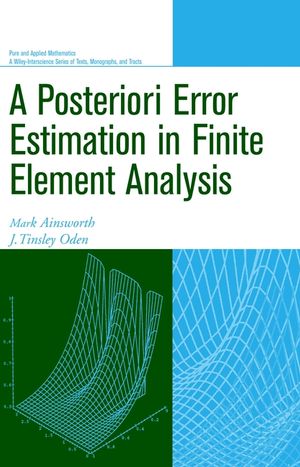A Posteriori Error Estimation in Finite Element AnalysisISBN: 978-0-471-29411-5
Hardcover
264 pages
September 2000
 This is a Print-on-Demand title. It will be printed specifically to fill your order. Please allow an additional 10-15 days delivery time. The book is not returnable.
|
||||||
Preface xiii
Acknowledgments xvii
1 Introduction 1
1.1 A Posteriori Error Estimation: The Setting 1
1.2 Status and Scope 2
1.3 Finite Element Nomenclature 4
1.3.1 Sobolev Spaces 5
1.3.2 Inverse Estimates 7
1.3.3 Finite Element Partitions 9
1.3.4 Finite Element Spaces on Triangles 10
1.3.5 Finite Element Spaces on Quadrilaterals 11
1.3.6 Properties of Lagrange Basis Functions 12
1.3.7 Finite Element Interpolation 12
1.3.8 Patches of Elements 13
1.3.9 Regularized Approximation Operators 14
1.4 Model Problem 15
1.5 Properties of A Posteriori Error Estimators 16
1.6 Bibliographical Remarks 18
2 Explicit A Posteriori Estimators 19
2.1 Introduction 19
2.2 A Simple A Posteriori Error Estimate 20
2.3 Efficiency of Estimator 23
2.3.1 Bubble Functions 23
2.3.2 Bounds on the Residuals 28
2.3.3 Proof of Two-Sided Bounds on the Error 31
2.4 A Simple Explicit Least Squares Error Estimator 32
2.5 Estimates for the Pointwise Error 34
2.5.1 Regularized Point Load 35
2.5.2 Regularized Green's Function 38
2.5.3 Two-Sided Bounds on the Pointwise Error 39
2.6 Bibliographical Remarks 4%
3 Implicit A Posteriori Estimators 43
3.1 Introduction 43
3.2 The Subdomain Residual Method 44
3.2.1 Formulation of Subdomain Residual Problem 45
3.2.2 Preliminaries 46
3.2.3 Equivalence of Estimator ^7
3.2.4 Treatment of Residual Problems 49
3.3 The Element Residual Method 50
3.3.1 Formulation of Local Residual Problem 50
3.3.2 Solvability of the Local Problems 52
3.3.3 The Classical Element Residual Method 54
3.3.4 Relationship with Explicit Error Estimators 54
3.3.5 Efficiency and Reliability of the Estimator 55
3.4 The Influence and Selection of Subspaces 56
3.4.1 Exact Solution of Element Residual Problem 56
3.4.2 Analysis and Selection of Approximate Subspaces 59
3.4.3 Conclusions 62
3.5 Bibliographical Remarks 63
4 Recovery-Based Error Estimators 65
4.1 Examples of Recovery-Based Estimators 66
4.1.1 An Error Estimator for a Model Problem in One Dimension 61
4.1.2 An Error Estimator for Bilinear Finite Element Approximation 69
4.2 Recovery Operators 72
4.2.1 Approximation Properties of Recovery Operators 73
4.3 The Superconvergence Property 75
4.4 Application to A Posteriori Error Estimation 76
4.5 Construction of Recovery Operators 77
4.6 The Zienkiewicz-Zhu Patch Recovery Technique 79
4.6.1 Linear Approximation on Triangular Elements 79
4.6.2 Quadratic Approximation on Triangular Elements 81
4.6.3 Patch Recovery for Quadrilateral Elements 82
4.7 A Cautionary Tale 82
4.8 Bibliographical Remarks 83
5 Estimators, Indicators, and Hierarchic Bases 85
5.1 Introduction 85
5.2 Saturation Assumption 88
5.3 Analysis of Estimator 89
5.4 Error Estimation Using a Reduced Subspace 90
5.5 The Strengthened Cauchy-Schwarz Inequality 94
5.6 Examples 98
5.7 Multilevel Error Indicators 100
5.8 Bibliographical Remarks 109
6 The Equilibrated Residual Method 111
6.1 Introduction 111
6.2 The Equilibrated Residual Method 112
6.3 The Equilibrated Flux Conditions 116
6.4 Equilibrated Fluxes on Regular Partitions 117
6.4.1 First-Order Equilibration Condition 118
6.4.2 The Form of the Boundary Fluxes 118
6.4.3 Equilibration Conditions in Terms of the Moments 120
6.4.4 Local Patch Problems for the Flux Moments 120
6.4.5 Procedure for Resolution of Patch Problems 123
6.4.6 Summary 127
6.5 Efficiency of the Estimator 128
6.5.1 Stability of the Equilibrated Fluxes 128
6.5.2 Proof of Efficiency of the Estimator 131
6.6 Equilibrated Fluxes on Partitions Containing Hanging Nodes 133
6.6.1 First-Order Equilibration 133
6.6.2 Flux Moments for Unconstrained Nodes 134
6.6.3 Flux Moments with Respect to Constrained Nodes 137
6.6.4 Recovery of Actual Fluxes 137
6.7 Equilibrated Fluxes for Higher-Order Elements 139
6.7.1 The Form of the Boundary Fluxes 141
6.7.2 Determination of the Flux Moments 141
6.8 Bibliographical Remarks 143
7 Methodology for the Comparison of Estimators 145
7.1 Introduction 145
7.2 Overview of the Technique 146
7.3 Approximation over an Interior Subdomain 149
7.3.1 Translation Invariant Meshes 149
7.3.2 Lower Bounds on the Error 152
7.3.3 Interior Estimates 153
7.4 Asymptotic Finite Element Approximation 157
7.4.1 Periodic Finite Element Projection on Reference Cell 157
7.4.2 Periodic Finite Element Projection on a Physical Cell 158
7.4.3 Periodic Extension on a Subdomain 159
7.4.4 Asymptotic Finite Element Approximation 160
7.5 Stability of Estimators 165
7.5.1 Verification of Stability Condition for Explicit Estimator 166
7.5.2 Verification of Stability Condition for Implicit Estimators 168
7.5.3 Verification of Stability Condition for Recovery-Based Estimator 169
7.5.4 Elementary Consequences of the Stability Condition 170
7.5.5 Evaluation of Effectivity Index in the Asymptotic Limit 172
7.6 An Application of the Theory 174
7.6.1 Computation of Asymptotic Finite Element Solution 174
7.6.2 Evaluation of the Error in Asymptotic Finite Element Approximation 178
7.6.3 Computation of Limits on the Asymptotic Effectivity Index for Zienkiewicz-Zhu Patch Recovery Estimator 180
7.6.4 Application to Equilibrated Residual Method 184
7.6.5 Application to Implicit Element Residual Method 184
7.7 Bibliographical Remarks 187
8 Estimation of the Errors in Quantities of Interest 189
8.1 Introduction 189
8.2 Estimates for the Error in Quantities of Interest 191
8.3 Upper and Lower Bounds on the Errors 193
8.4 Goal-Oriented Adaptive Refinement 197
8.5 Example of Goal-Oriented Adaptivity 198
8.5.1 Adaptivity Based on Control of Global Error in Energy 198
8.5.2 Goal-Oriented Adaptivity Based on Pointwise Quantities of Interest 198
8.6 Local and Pollution Errors 202
8.7 Bibliographical Remarks 205
9 Some Extensions 207
9.1 Introduction 207
9.2 Stokes and Oseen's Equations 208
9.2.1 A Posteriori Error Analysis 211
9.2.2 Summary 218
9.3 Incompressible Navier-Stokes Equations 219
9.4 Extensions to Nonlinear Problems 222
9.4.1 A Class of Nonlinear Problems 222
9.4.2 A Posteriori Error Estimation 224
9.4.3 Estimation of the Residual 225
9.5 Bibliographical Remarks 227
References 229
Index 239



